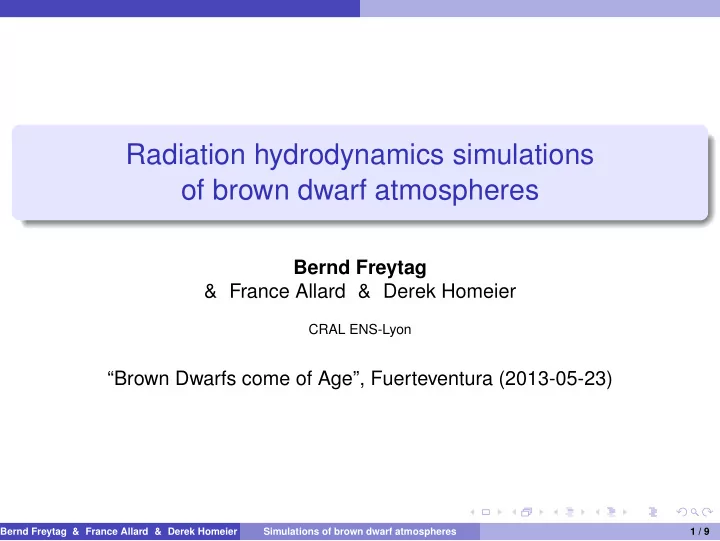

Radiation hydrodynamics simulations of brown dwarf atmospheres Bernd Freytag & France Allard & Derek Homeier CRAL ENS-Lyon “Brown Dwarfs come of Age”, Fuerteventura (2013-05-23) Bernd Freytag & France Allard & Derek Homeier (CRAL ENS-Lyon) Simulations of brown dwarf atmospheres 1 / 9
Introduction Dynamical stellar atmospheres CO5BOLD code: Betelgeuse Sun (Magneto-)Hydrodynamics: 2D/3D, compressible, Observations transsonic flow, shocks, ionization, gravity, advection of additional densities Radiation transport: optically thick and thin, non-local, frequency-dependence via opacity binning Simulations 2 geometrical setups: local ’box-in-a-star’ & global ’star-in-a-box’ models Bernd Freytag & France Allard & Derek Homeier (CRAL ENS-Lyon) Simulations of brown dwarf atmospheres 2 / 9
Introduction General properties of solar-like granulation 2.5 5 2.0 4 1.5 z [Mm] 3 z [Mm] 1.0 2 0.5 1 0.0 1 2 3 4 5 1 2 3 4 5 x [Mm] x [Mm] Surface intensity snapshot and entropy slice of solar model; 5782 K, log g =4.44, 5.6 2 × 2.8 Mm 3 , 800 2 × 400 grid points Bright granules and dark intergranular lanes Overshoot Downdrafts: largest convective velocities, shear, turbulence, vorticity Waves travel into the photosphere and transform into shocks Bernd Freytag & France Allard & Derek Homeier (CRAL ENS-Lyon) Simulations of brown dwarf atmospheres 3 / 9
From the Sun to brown dwarfs Transition from the Sun to brown dwarfs 2.0 0 1.8 -1 log(v vert,rms /[km/s]) s [10 9 erg/K/g] 1.6 -2 1.4 T eff =5782K, logg= 4.44 -3 T eff =4510K, logg= 4.50 1.2 T eff =3275K, logg= 5.00 T eff =2617K, logg= 5.00 1.0 T eff =2250K, logg= 5.00 -4 T eff =2056K, logg= 5.00 T eff =1862K, logg= 5.00 0.8 T eff =1532K, logg= 5.00 -5 2 4 6 8 2 4 6 8 log(P/[dyn/cm 2 ]) log(P/[dyn/cm 2 ]) Entropy and rms vertical velocity for selected (sub)stellar models Energy flux ↓ , velocities, Mach numbers ↓ Radiative time scales ↑ Stabilizing buoyancy forces ↑ , horizontal vs. vertical velocities ↑ Overshoot velocity scale height in BDs ↓ Acoustic waves ↓↓ , gravity waves ↓ Bernd Freytag & France Allard & Derek Homeier (CRAL ENS-Lyon) Simulations of brown dwarf atmospheres 4 / 9
From the Sun to brown dwarfs Consequences for RHD models Solar-like stars ◮ Two state variables, e.g. ρ and e i ◮ EOS and κ from lookup tables Dusty objects ◮ Dust properties depend on history ◮ Additional density arrays ρ dust , i ◮ Nucleation, growth, grains sizes, composition, opacities ◮ Simple dust models: ⋆ 4-moment model for carbon-rich dust in AGB stars (Freytag & H¨ ofner 2008) ⋆ 2-bin model for forsterite in brown dwarfs (Freytag et al. 2010) ⋆ Multi-size-bin model for forsterite in brown dwarfs ◮ Mach numbers from ∼ 1 to small values ◮ Local and global scales Bernd Freytag & France Allard & Derek Homeier (CRAL ENS-Lyon) Simulations of brown dwarf atmospheres 5 / 9
Results Dust cloud layers above the convection zone Entropy fluctuations and dust concentration of 2D model with 1800 K/log g =5. Dust clouds (affect spectra and cause variability) Mixing by waves, overshoot, and cloud convection (Freytag et al. 2010) Parametrized mixing put into Phoenix code (Allard et al. 2010, 2012) Bernd Freytag & France Allard & Derek Homeier (CRAL ENS-Lyon) Simulations of brown dwarf atmospheres 6 / 9
Results Small-scale cloud patterns in local 3D models Surface intensity T sequence: ◮ 2600 K ◮ 2200 K ◮ 2000 K ◮ 1800 K ◮ at log g =5 Increasing thickness of the dark dust clouds above the granules Bernd Freytag & France Allard & Derek Homeier (CRAL ENS-Lyon) Simulations of brown dwarf atmospheres 7 / 9
Results Global 3D toy models st22g35n04 t= 15.8 h BD/planet toy models: 10 st22g35n02 t= 82.0 h 10 2200 K/log g =3.5 5 5 Radius scaled 1:20 375 3 points, no dust: 0 0 ◮ Surface intensity -5 -5 415 3 points, dust -10 (2-bin forsterite) -10 -10 -5 0 5 10 -10 -5 0 5 10 ◮ Surface intensity x [Mm] x [Mm] st22g35n04 t= 15.8 h st22g35n04 t= 15.8 h ◮ Entropy slice 10 10 ◮ Dust concentration slice 5 5 0 0 -5 -5 -10 -10 -10 -5 0 5 10 -10 -5 0 5 10 x [Mm] x [Mm] Bernd Freytag & France Allard & Derek Homeier (CRAL ENS-Lyon) Simulations of brown dwarf atmospheres 8 / 9
Conclusions Conclusions Local mixing and transport of dust ◮ Overshoot, gravity waves, dust-cloud convection ◮ Fast small-scall intensity fluctuations Feedback mechanisms ◮ Dust clouds → convection → mixing → dust clouds ◮ Dust clouds → no nucleation → no new grains Future work ◮ Larger local and “global” models ◮ Improved dust microphysics ◮ Rotation ◮ Magnetic activity (M dwarfs) ◮ Postprocessing: spectrum synthesis with Phoenix Bernd Freytag & France Allard & Derek Homeier (CRAL ENS-Lyon) Simulations of brown dwarf atmospheres 9 / 9
Recommend
More recommend